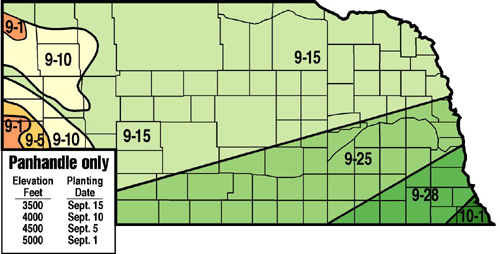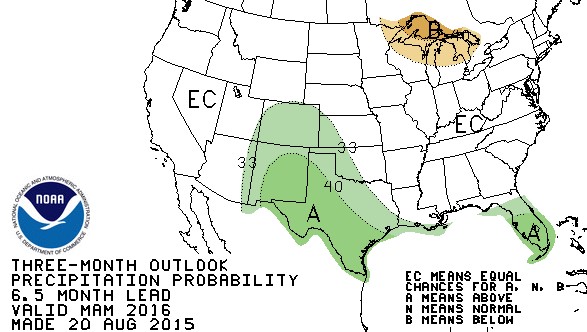Good Soil Moisture Exists for Planting 2016 Wheat
The unusual wet spring this year did more harm than good for wheat growers in western Nebraska. The wet weather brought disease and in much of the Panhandle, snow. Although the weather was a drag on this year's wheat yields, it may reward growers with favorable yields in 2016.
Year-to-date precipitation at the High Plains Ag Lab (HPAL) in Sidney is already over 18 inches. The average precipitation over the last 67 years at HPAL is 16.8 inches. With four months remaining, this year's rain totals will keep adding to this above-average year, providing good soil moisture for seeding winter wheat.

Higher seeding rates should be used when planting late or when supplemental irrigation is available. The point of diminishing returns for seeding rate is 18 seeds per foot of row, no matter what row spacing is used. For further information, see the NebGuide, Seeding Rates for Winter Wheat in Nebraska (G2056).


Looking ahead to next year, the Climate Prediction Center is predicting normal temperatures and precipitation for Nebraska. See Figure 3 for the precipitation forecast for March, April, and May.
Nutrient Management for 2016 Wheat Crop With the possibility of favorable weather for the 2016 wheat crop, soil nutrients need to be properly managed to achieve optimum yields. Typically, as rainfall in dryland areas increases, yield potential increases. With the wet year we just had, many growers did not provide adequate nitrogen to their wheat crops and yield and quality suffered. Dryland growers are naturally hesitant of committing too many inputs into a crop for fear sufficient rain will not come to realize their expected yields. Split fertilizer applications allow the grower to protect themselves from the financial risk of applying too much fertilizer while also protecting yields.
Split fertilizer applications can be applied as needed to a wheat crop. Growers can apply a minimal amount nitrogen and phosphorus in the fall to stimulate growth. In the spring and as favorable weather and precipitation persist, growers can fertilize their wheat crop to increase yield potential and protect grain quality. Growers should evaluate the crop's yield potential based on plant stands and moisture then add nitrogen as recommended in the NebGuide Fertilizing Winter Wheat.
Conditions are right for a good 2016 wheat crop. Use the tools and information provided at cropwatch.unl.edu/wheat for managing all aspects of your wheat crop. Information will be added throughout the growing season to address issues growers are facing.Cody Creech
Dryland Cropping Systems Specialist
Online Master of Science in Agronomy
With a focus on industry applications and research, the online program is designed with maximum flexibility for today's working professionals.
